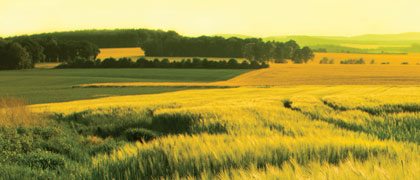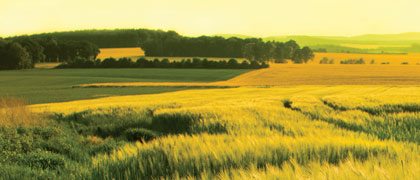
A Brave New World
Genomics research and development projects are opening markets and widening opportunities in Canada. How will the increasing focus on the genetic makeup of crops affect the seed industry?
Genomics is a term that usually conjures images of white lab coats and microscopes, not sweeping vistas of Canadian prairies and field crops ripe for harvesting. But increasingly, crops planted in the spring are at least partially developed in labs in Canada and abroad.
Research and development in genomics has yielded extraordinary results, the full effects of which are usually not felt until years after researchers compile their results, when new varieties hit the market — and then the soil. But recent work in genomics in Canada may change everything for producers both in Canada and the developing world.
In the Prairies, several organizations are on the cutting edge of new developments in genomics, including Genome Prairie and Saskatoon-based Ag-West Bio Inc.
“Biotechnology includes a suite of technologies and is a broad set of
|
Genome Prairie is a not-for-profit organization supporting stakeholders across Manitoba and Saskatchewan. According to Chris Barker, Genome Prairie’s chief scientific officer, the organization’s primary mission is to translate genomic discoveries into social and economic benefits for Canadians and the world by developing, investing in and managing large-scale public-private collaborations in the Prairie region.
“What we’re primarily here to do is help the community develop large-scale genomics-based collaborations,” explains Barker. “These collaborations are complicated, multi-institutional and often multinational projects, and therefore require skilled leadership and management to assist the team in building partnerships and meeting their goals.”
Genome Prairie’s recent projects have included work with oilseeds, wheat and flax. The Total Utilization of Flax Genomics (TUFGEN) project, which began in 2009 and is to be completed soon, aims to “increase the benefits and versatility of flax by developing genomic-based tools to assist in crop breeding, to improve field performance, and to enhance seed and fibre traits.”
The TUFGEN project has been extremely successful, according to Barker. “By sequencing the entire flax genome and making it available to researchers and breeders around the world, TUFGEN has ensured that flax is one of the cutting-edge crops in terms of genomics tools,” he says.
Now, this genotypic data can be matched with phenotypic data, and brought into breeding programs for the development of new varieties with interesting phenotypic characteristics, according to Barker. “The TUFGEN project was truly foundational, and now there will be other, smaller projects with flax to use this data and do phenotype-specific development either for the breeders or for processors.”
But these days, one of the most important projects for Genome Prairie involves wheat. The company is working with the Canadian Triticum Advancement through Genomics project, a co-ordinated effort to sequence the wheat genome. Funded by Genome Canada and various industry partners and co-funders, including the province of Saskatchewan and Western Grains Research Foundation, CTAG has brought a Canadian presence to the international wheat development effort for the first time in years, according to Barker.
The wheat genome is notoriously large and complex, so unlocking its genetic code offers important opportunities. It contains 21 chromosomes, and countries around the world have “signed up” to complete the sequencing of each of those chromosomes. Canada’s role is to complete sequencing for chromosome 1a, says Barker. “The effort has picked up speed, and we expect that in two years’ time we will have the [wheat] chromosome 1a ready — that will be Canada’s contribution,” he says.
Community Efforts
As with the wheat genome project, large-scale genomic projects tend to be community efforts.
“These collaborations are complicated, multi-institutional and often multinational projects, and therefore require skilled leadership and management to assist the team in building partnerships and meeting their goals.”
|
Wilf Keller, Ag-West Bio’s president and CEO, believes that work in genomics must involve a variety of key players in order to corral the resources and know-how to complete a project.
A not-for-profit organization funded by Saskatchewan’s Ministry of Agriculture and Agriculture and Agri-Food Canada’s Growing Forward 2 program, Ag-West Bio keeps its “finger” on the pulse of genomics research and development in the province, and helps members with networking, promotion and educational opportunities, along with seeking out sources of funding for projects. “We see ourselves as a catalyst in two broad areas: the first is commercialization to help grow small companies,” says Keller. “The second area is in building the biosciences community in Saskatchewan.”
Ag-West Bio is currently working in a variety of areas, including research and development of oilseed crops Camelina sativa and Brassica carinata for industrial use, and the BreadBasket 2.0 project, a “pan-prairie” project that aims to promote innovation in field crops in Western Canada. The organization is also investigating a range of other projects, including the development of value-added food crops and processing to produce food ingredients. Such initiatives are highly relevant to growing markets in Asia, says Keller.
Essentially, Ag-West’s mission is to connect knowledge with resources, with the ultimate goal of increasing the marketability and profitability of agricultural products. “We’re a bridge-builder. We make sure people know what’s going on and assist in finding funds and connecting people,” says Keller.
Advancements in biotechnology, he says, are responsible for massive developments in oilseed crops such as canola, a crop Ag-West Bio has supported extensively in the past.
However, he believes that “biotechnology” is a term that is often misused by those who equate it with “genetic modification” alone. “Biotechnology includes a suite of technologies and is a broad set of tools, and genetic engineering is only part of that,” he argues. “Biotechnology can involve tissue culture methods or molecular markers for testing or diagnosing plants.”
In the case of canola, as much as 98 per cent of the crops planted in Canada have been modified for certain traits, such as herbicide tolerance and hybrid vigour, he says. Because of these developments, 228,000 people are employed in Canada’s canola industry, and once this year’s crop is harvested, the industry could be valued at $17 billion.
Ag-West Bio’s recent work with oilseeds such as camelina and carinata has involved working with geneticists investigating their potential for bioindustrial uses and the production of high-quality industrial lubricants and polymers.
“These crops are new, and so they need a lot of attention,” says Keller.
Regulatory Challenges
While the first step to encouraging robust field crop industries in Western Canada is arguably in genetic research, the ultimate goal — actually planting the seeds and growing crops for export — can seem remote. Especially challenging is the relatively vigorous regulatory system in Canada, which may seem prohibitive to new developments in genomics.
“In Canada, we have fairly strict variety registration requirements compared to other jurisdictions,” says Barker. “In the States, if you can grow it you can register and sell it. Here, varieties need to be proven in co-op trials and compared to the checked varieties — the gold standards.”
And when it comes to international trade, what some see as positive biotechnological developments at home can be downright problematic for importers abroad.
There are both positives and negatives to such stringent regulatory requirements, says Barker. Regulations exist to ensure the quality of the product. And Canada’s international reputation is important to maintain, especially when it comes to high-quality commodity crops that fetch a premium, such as wheat, he says. “But there are a lot of other markets potentially available if the regulatory system is opened up enough to allow people to try different things and produce different varieties that may have a different niche in the marketplace.”
In the development of niche crops, as well as contributions to international research efforts, Canada has found a place at the cutting-edge of a brave new world in genomics.
Julienne Isaacs











